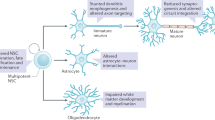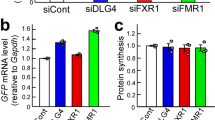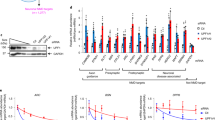Abstract
Fragile X syndrome is caused by a loss of expression of the fragile X mental retardation protein (FMRP). FMRP is a selective RNA-binding protein which forms a messenger ribonucleoprotein (mRNP) complex that associates with polyribosomes. Recently, mRNA ligands associated with FMRP have been identified. However, the mechanism by which FMRP regulates the translation of its mRNA ligands remains unclear. MicroRNAs are small noncoding RNAs involved in translational control. Here we show that in vivo mammalian FMRP interacts with microRNAs and the components of the microRNA pathways including Dicer and the mammalian ortholog of Argonaute 1 (AGO1). Using two different Drosophila melanogaster models, we show that AGO1 is critical for FMRP function in neural development and synaptogenesis. Our results suggest that FMRP may regulate neuronal translation via microRNAs and links microRNAs with human disease.
This is a preview of subscription content, access via your institution
Access options
Subscribe to this journal
Receive 12 print issues and online access
$209.00 per year
only $17.42 per issue
Buy this article
- Purchase on SpringerLink
- Instant access to full article PDF
Prices may be subject to local taxes which are calculated during checkout




Similar content being viewed by others
References
O'Donnell, W.T. & Warren, S.T. A decade of molecular studies of fragile X syndrome. Annu. Rev. Neurosci. 25, 315–338 (2002).
Siomi, M.C. et al. FXR1, an autosomal homolog of the fragile X mental retardation gene. Embo J. 14, 2401–2408 (1995).
Zhang, Y. et al. The fragile X mental retardation syndrome protein interacts with novel homologs FXR1 and FXR2. Embo J. 14, 5358–5366 (1995).
Li, Z. et al. The fragile X mental retardation protein inhibits translation via interacting with mRNA. Nucleic Acids Res. 29, 2276–2283 (2001).
Laggerbauer, B., Ostareck, D., Keidel, E.M., Ostareck-Lederer, A. & Fischer, U. Evidence that fragile X mental retardation protein is a negative regulator of translation. Hum. Mol. Genet. 10, 329–338 (2001).
Comery, T.A. et al. Abnormal dendritic spines in fragile X knockout mice: maturation and pruning deficits. Proc. Natl. Acad. Sci. USA 94, 5401–5404 (1997).
Hinton, V.J., Brown, W.T., Wisniewski, K. & Rudelli, R.D. Analysis of neocortex in three males with the fragile X syndrome. Am. J. Med. Genet. 41, 289–294 (1991).
Nimchinsky, E.A., Oberlander, A.M. & Svoboda, K. Abnormal development of dendritic spines in FMR1 knock-out mice. J. Neurosci. 21, 5139–5146 (2001).
Feng, Y. et al. Fragile X mental retardation protein: nucleocytoplasmic shuttling and association with somatodendritic ribosomes. J. Neurosci. 17, 1539–1547 (1997).
Bardoni, B. & Mandel, J.L. Advances in understanding of fragile X pathogenesis and FMRP function, and in identification of X linked mental retardation genes. Curr. Opin. Genet. Dev. 12, 284–293 (2002).
Huber, K.M., Gallagher, S.M., Warren, S.T. & Bear, M.F. Altered synaptic plasticity in a mouse model of fragile X mental retardation. Proc. Natl. Acad. Sci. USA 99, 7746–7750 (2002).
Schaeffer, C. et al. The fragile X mental retardation protein binds specifically to its mRNA via a purine quartet motif. Embo J. 20, 4803–4813 (2001).
Brown, V. et al. Microarray identification of FMRP-associated brain mRNAs and altered mRNA translational profiles in fragile X syndrome. Cell 107, 477–487 (2001).
Darnell, J.C. et al. Fragile X mental retardation protein targets G quartet mRNAs important for neuronal function. Cell 107, 489–499 (2001).
Miyashiro, K.Y. et al. RNA cargoes associating with FMRP reveal deficits in cellular functioning in Fmr1 null mice. Neuron 37, 417–431 (2003).
Sung, Y.J. et al. The fragile X mental retardation protein FMRP binds elongation factor 1A mRNA and negatively regulates its translation in vivo. J. Biol. Chem. 278, 15669–15678 (2003).
Zalfa, F. et al. The fragile X syndrome protein FMRP associates with BC1 RNA and regulates the translation of specific mRNAs at synapses. Cell 112, 317–327 (2003).
Ceman, S. et al. Phosphorylation influences the translation state of FMRP-associated polyribosomes. Hum. Mol. Genet. 12, 3295–3305 (2003).
Cerutti, H. RNA interference: traveling in the cell and gaining functions? Trends Genet. 19, 39–46 (2003).
Hammond, S.M., Caudy, A.A. & Hannon, G.J. Post-transcriptional gene silencing by double-stranded RNA. Nat. Rev. Genet. 2, 110–119 (2001).
Pasquinelli, A.E. & Ruvkun, G. Control of developmental timing by microRNAs and their targets. Annu. Rev. Cell Dev. Biol. 18, 495–513 (2002).
McManus, M.T. & Sharp, P.A. Gene silencing in mammals by small interfering RNAs. Nat. Rev. Genet. 3, 737–747 (2002).
Bernstein, E., Caudy, A.A., Hammond, S.M. & Hannon, G.J. Role for a bidentate ribonuclease in the initiation step of RNA interference. Nature 409, 363–366 (2001).
Carmell, M.A., Xuan, Z., Zhang, M.Q. & Hannon, G.J. The Argonaute family: tentacles that reach into RNAi, developmental control, stem cell maintenance, and tumorigenesis. Genes Dev. 16, 2733–2742 (2002).
Ishizuka, A., Siomi, M.C. & Siomi, H. A Drosophila fragile X protein interacts with components of RNAi and ribosomal proteins. Genes Dev. 16, 2497–2508 (2002).
Caudy, A.A., Myers, M., Hannon, G.J. & Hammond, S.M. Fragile X-related protein and VIG associate with the RNA interference machinery. Genes Dev. 16, 2491–2496 (2002).
Jin, P. & Warren, S.T. New insights into fragile X syndrome: from molecules to neurobehaviors. Trends Biochem. Sci. 28, 152–158 (2003).
Hammond, S.M., Boettcher, S., Caudy, A.A., Kobayashi, R. & Hannon, G.J. Argonaute2, a link between genetic and biochemical analyses of RNAi. Science 293, 1146–1150 (2001).
Mourelatos, Z. et al. miRNPs: a novel class of ribonucleoproteins containing numerous microRNAs. Genes Dev. 16, 720–728 (2002).
Bontekoe, C.J. et al. Knockout mouse model for Fxr2: a model for mental retardation. Hum. Mol. Genet. 11, 487–498 (2002).
The Dutch-Belgian Fragile X Consortium. Fmr1 knockout mice: a model to study fragile X mental retardation. Cell 78, 23–33 (1994).
Doi, N. et al. Short-interfering-RNA-mediated gene silencing in mammalian cells requires Dicer and eIF2C translation initiation factors. Curr. Biol. 13, 41–46 (2003).
Wan, L., Dockendorff, T.C., Jongens, T.A. & Dreyfuss, G. Characterization of dFMR1, a Drosophila melanogaster homolog of the fragile X mental retardation protein. Mol. Cell. Biol. 20, 8536–8547 (2000).
Zhang, Y.Q. et al. Drosophila fragile X-related gene regulates the MAP1B homolog Futsch to control synaptic structure and function. Cell 107, 591–603 (2001).
Williams, R.W. & Rubin, G.M. ARGONAUTE1 is required for efficient RNA interference in Drosophila embryos. Proc. Natl. Acad. Sci. USA 99, 6889–6894 (2002).
Kataoka, Y., Takeichi, M. & Uemura, T. Developmental roles and molecular characterization of a Drosophila homologue of Arabidopsis Argonaute1, the founder of a novel gene superfamily. Genes Cells 6, 313–325 (2001).
Dockendorff, T.C. et al. Drosophila lacking dfmr1 activity show defects in circadian output and fail to maintain courtship interest. Neuron 34, 973–984 (2002).
Martin, K.C. & Kosik, K.S. Synaptic tagging—who's it? Nat. Rev. Neurosci. 3, 813–820 (2002).
Antar, L.N. & Bassell, G.J. Sunrise at the synapse: the FMRP mRNP shaping the synaptic interface. Neuron 37, 555–558 (2003).
Acknowledgements
The authors would like to thank G. Dreyfuss for anti-eIF2C2, anti-dFMR1 monoclonal 6A15 and anti-polyA binding protein antibodies, and J. Taylor and R. Apkarian for technical assistance. This work was supported, in part, by grants from the Rett Syndrome Research Foundation (P.J.), the FRAXA Research Foundation (D.Z.) and National Institute of Health grants to D.C.Z., S.C., T.A.G., D.L.N., K.M. and S.T.W.
Author information
Authors and Affiliations
Corresponding author
Ethics declarations
Competing interests
The authors declare no competing financial interests.
Supplementary information
Supplementary Fig. 1
Proposed model of FMRP function via microRNA pathway. FMRP interacts with AGO1 and Dicer in vivo and may participate the processing of microRNA precursors into mature microRNAs. The G-quartet/stem structure is required for the initial recognition of its mRNA ligands by FMRP (low-specificity scanning). Once FMRP binds to its mRNA ligands, it will recruit AGO1 along with microRNAs to its mRNA ligands and facilitate the recognition of microRNA complementary sequence (high-specificity interrogation), which leads to efficient translation suppression. (PDF 54 kb)
Rights and permissions
About this article
Cite this article
Jin, P., Zarnescu, D., Ceman, S. et al. Biochemical and genetic interaction between the fragile X mental retardation protein and the microRNA pathway. Nat Neurosci 7, 113–117 (2004). https://doi.org/10.1038/nn1174
Received:
Accepted:
Published:
Issue Date:
DOI: https://doi.org/10.1038/nn1174
This article is cited by
-
The multifaceted role of Fragile X-Related Protein 1 (FXR1) in cellular processes: an updated review on cancer and clinical applications
Cell Death & Disease (2024)
-
The molecular biology of FMRP: new insights into fragile X syndrome
Nature Reviews Neuroscience (2021)
-
The Potential Role of miRNAs as Predictive Biomarkers in Neurodevelopmental Disorders
Journal of Molecular Neuroscience (2021)
-
Post-translational modifications of the Fragile X Mental Retardation Protein in neuronal function and dysfunction
Molecular Psychiatry (2020)
-
The RNA-binding fragile-X mental retardation protein and its role beyond the brain
Biophysical Reviews (2020)



